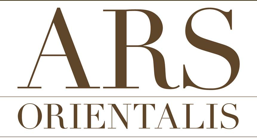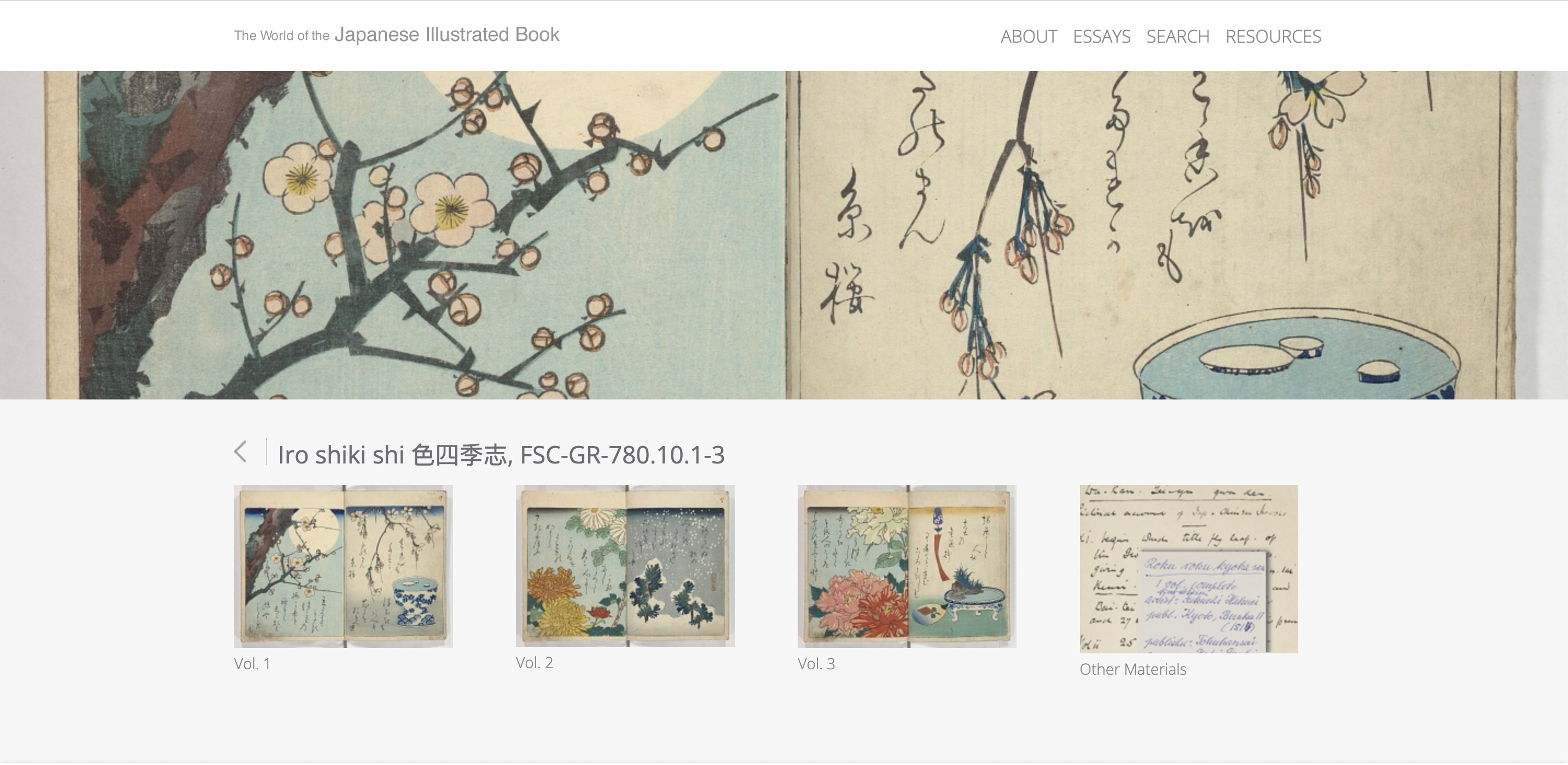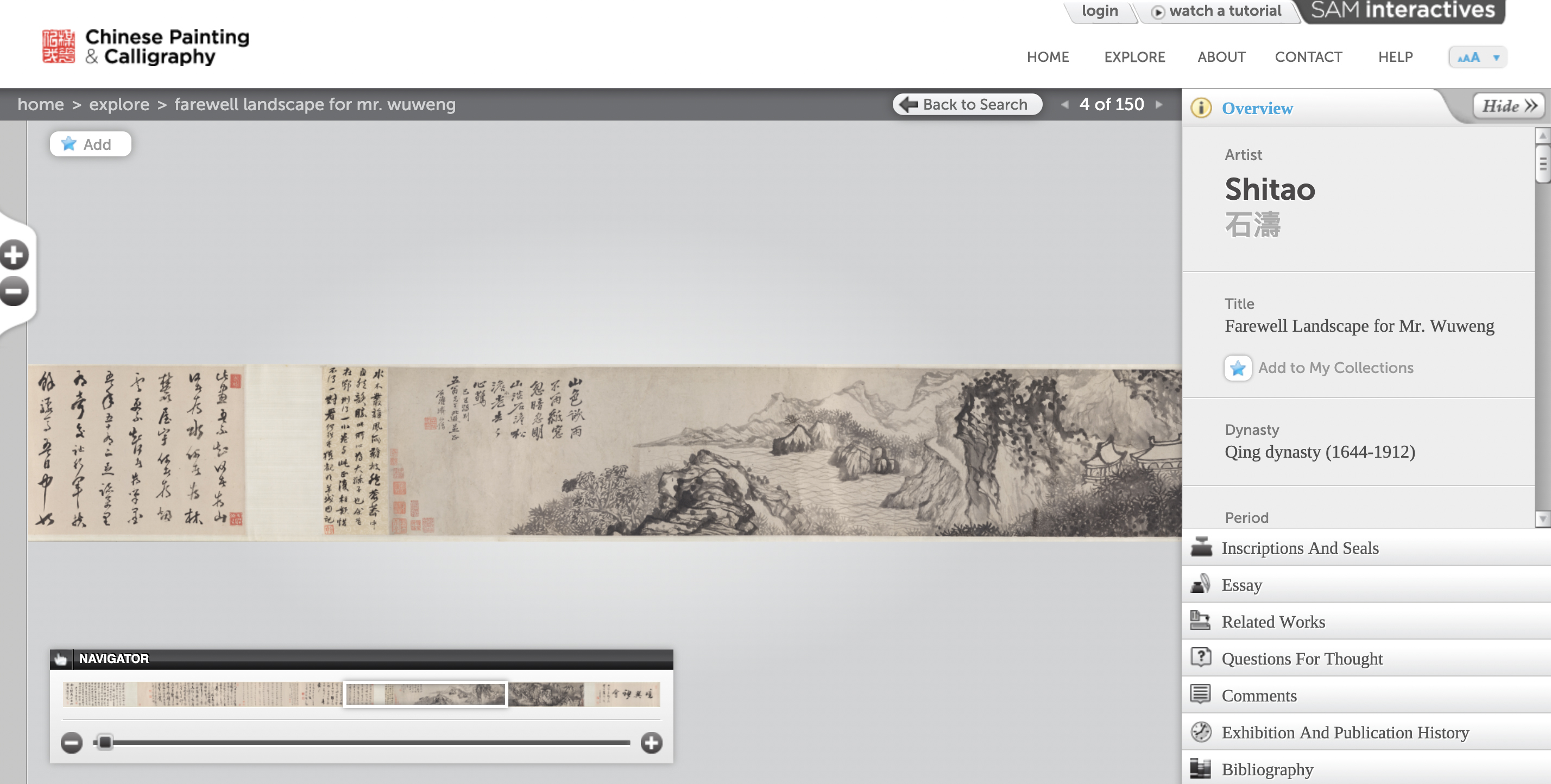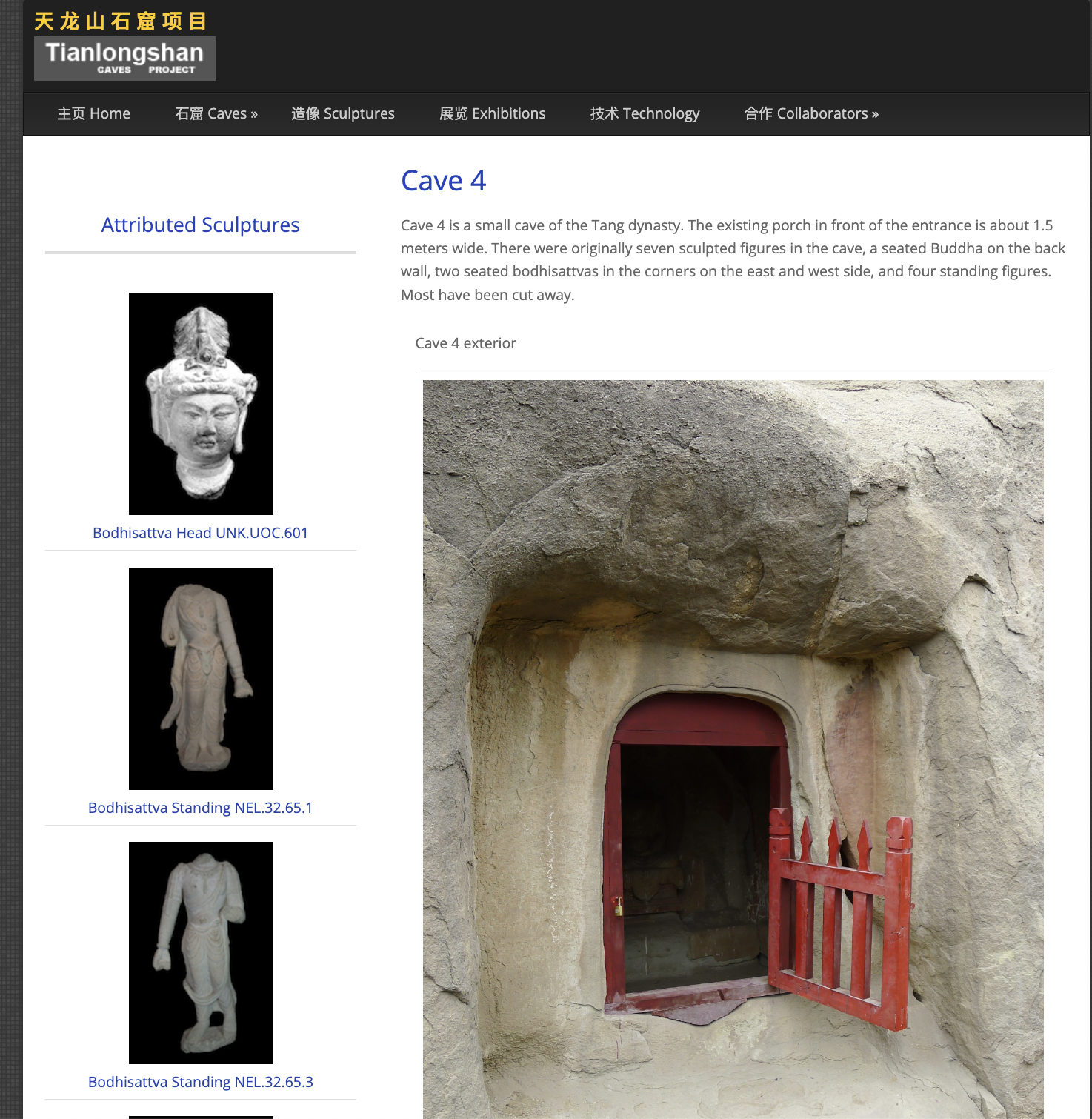In the ten years since this journal began its Digital Initiatives section, the use of digital technologies for the compilation, analysis, and dissemination of research in the humanities has grown exponentially. In some fields, it is almost unnecessary to speak of “digital methods,” as digital data and their analysis have become so established as to be, if not ubiquitous, then widely understood and accepted by the field. In others, including art history, expansion has been less linear but perhaps more diverse in the forms digital work has taken and the historiographic challenges scholars have sought to address. Nonetheless, a decade on, we seem, particularly in Asian art, to still be seeking not only a critical mass in terms of engagement, but also a clear sense of the potential for the digital in our field.
This essay constitutes a brief reflection on where we have been and where we might be going in the use of digital tools and methods in Asian art history. It is not a review of past projects so much as a chance to think about how we, as historians of Asian art, are engaging with the digital, and how that engagement may speak to our sense of the field. I am particularly interested in how the digital casts core questions about the study of Asian art in relief, both as a field, or series of fields, unto itself/themselves, and in relation to the broader discipline of art history, which arguably remains fundamentally Eurocentric in both its intellectual orientation and institutional structures. How can the digital help address historic, structural biases, inequities, or injustices as they relate to Asian art? Can it help decenter the discipline of art history, whether by repositioning Asian and other “non-Western” fields relative to the center or by moving toward a more inclusively defined study? And how can the digital be not just a novel means of dissemination, but also a mechanism for asking new questions and charting new directions in the field? These are quite broad questions, much larger than can be adequately addressed here. Yet they also touch on issues at the heart of art historical practice—sources, materiality, the nature of the object, and historiography— that constitute points of inflection in the study of the arts of Asia and those elsewhere in the world, and thus offer useful starting points for further discussion.
Digitization and Access
As in other fields of art and architectural history, the rapid growth of digitization, aided by technological developments, funding priorities, and economies of scale, has radically transformed both access to, and the study of, the arts of Asia. The relationship between photography and canon formation is as strong for Asian art as it is for European, and generations of scholars and students have been substantially constrained by the published corpus of well-known works.1 Large digitization projects, such Google Arts & Culture and ARTstor, remain strongly biased toward Euro-American art, whether due to owner preference, algorithmic bias, market demand, selective participation on the part of contributing institutions, or other factors.2 The efforts of individual museums, both large and small, have greatly increased access across a geographically disparate network of practitioners and objects, but with uneven results. In Chinese painting, for instance, the online publication of objects in Beijing's Palace Museum and Taipei's National Palace Museum have aided research into collections that were previously known largely through expensive print publications that frequently used black-and-white reproductions.3 These online resources still have limitations—both remain incomplete, favoring certain types of work (scroll painting) while largely excluding others (e.g., maps and sets of painting), thus reinforcing aspects of canonicity. While many of Taipei's images are freely downloadable through the museum's new Open Data program, Beijing's remain watermarked and confined within an online viewer. In both cases, access to information and scholarship about the works remains limited beyond essential metadata.4
Some online catalogues have extended well beyond these basic models in compelling ways, however, offering deeper scholarly content, more curated presentation, and even interactivity that responds to the materials, formats, and viewing practices distinct to their subject matter. The National Museum of Asian Art Library's online repository of Japanese illustrated books from the Edo and Meiji periods includes not only the relatively straightforward digitization of Charles Lang Freer's collection of over 1,350 volumes, but a rich and multifaceted presentation of the nearly 2,000-volume Pulverer Collection, titled The World of the Japanese Illustrated Book (fig. 1).5 High-resolution scans of the books, discoverable through a multifaceted search tool, are complemented by a rich range of essays and videos by leading scholars discussing the collection and Japanese print culture more broadly. Accessible to both scholarly and lay audiences, the project explores the process of Japanese printing, from artistic conception and design to production and the commercial market, straddling the line between scholarly catalogue and exhibition. Similarly, the Seattle Art Museum's Chinese Painting and Calligraphy catalogue, built as part of the Getty Foundation's Online Scholarly Catalogue Initiative (OSCI), presents high-resolution photography and rich explanatory material in a bespoke online interface that strongly evokes the embodied and intellectual experience of viewing Chinese scrolls (fig. 2).6 Detailed annotation of selected works identifies and translates inscriptions and seals, while scholarly essays offer deeper insight. Like the Pulverer catalogue, it is a “work in progress,” in that not all paintings were fully annotated at the time of publication; Seattle's catalogue explicitly invites engagement with the collection by encouraging scholars to contribute essays and other research, and also allows users to create their own collections and notes, making it a useful tool for teaching and study.
The motivations and benefits of this drive for digitization seem clear and essentially positive—an investment in access to information and openness to knowledge, an expansion of what constitutes the subjects and objects of our disciplines, and a more interconnected field, among the most obvious. At the same time, they highlight areas of continued need and structural challenges inherent to the digital turn. These projects are, first and foremost, resource intensive, not just in terms of scholarship but most significantly in terms of cost. By making elite and metropolitan collections even more accessible than they were before, digitization has, to a significant extent, reinforced the hierarchies of a “global” art world defined by Euro-American institutions and networks, rather than destabilizing or undermining them. The rich collections of local and provincial institutions across Asia, those that stand largely outside the networks of our discipline at the international level of research and exhibition, remain disconnected from the virtual network promised by digital humanities. Institutional and national politics mean that collections also remain relatively siloed from one another; we thus remain a long way from the dream of a “union catalogue” of Indian painting or Chinese porcelain as envisioned by many. This is, in part, a reflection of our political age, one in which national borders and identities all over the world are hardening, rather than becoming more permeable. It is also a function of the biases of funding and institutionalization, however, something over which we potentially have greater control as we think toward the next phase of the digital transformation of knowledge and the arts.
Modeling and Dissemination
Political circumstances and financial constraints are only two of the many contemporary concerns that are shaping art historical practice in and about Asia. Climate change, war, political regimes, the pressures of modern tourism, ethical decisions about travel, and the simple passage of time have all threatened sites and objects or made them inaccessible to scholars and public alike. In many cases, these factors coincide with historiographic neglect, such that subjects outside the canon are doubly erased. Digital reconstructions in two, three, and four dimensions offer innovative environments for iterative research and analysis, as well as the means for interactive presentations of monuments that are lost or cannot sustain the impact of visitors.
Numerous projects over the last decade have explored the possibilities of mapping, 3-D modeling, and extended reality (XR) in our field.7 Of particular interest are those that have allowed researchers to visualize lost sites and landscapes. Relying on remote-sensing laser technology, or LIDAR, to “see through” the forest canopy around the Tonlé Sap and Kulen Hills in Cambodia, the Greater Angkor Project, for instance, has revolutionized understandings of the Angkor region over the course of Khmer civilization, circa ninth to sixteenth centuries CE.8 The highly detailed maps the project produced not only revealed the “most extensive urban complex of the early modern world,” but, once processed through GIS (geographic information system) software such as ArcGIS, resulted in a flexible, queryable database that has served as the foundation for numerous subsequent studies, both small and large scale.9 Similarly, two international collaborations spearheaded by the Center for the Art of East Asia at the University of Chicago have sought to reconstruct early Buddhist sites damaged by theft and sale of sculptures on the international market.10 Focusing on Xiangtangshan, a Northern Qi (550–577) site in southern Hebei province, and Tianlongshan, in Shanxi province, which was developed between the sixth and ninth centuries, researchers identified and created 3-D scans of missing sculptures now located in museum and private collections around the world (fig. 3). This has permitted both detailed study of the sculptures themselves and the digital re-creation of the sites as they once existed, a virtual “re-racination” that draws attention to larger issues of provenance, the art market, and the global asymmetries that underpin the material histories and historiographies of our field.
Given threats to cultural heritage throughout the world, 3-D modeling of architecture and space has become a particularly important tool for historians, heritage conservationists, and others. Researchers at Tsinghua University School of Architecture have constructed extensive 3-D models of the Qing imperial garden Yuanmingyuan, which was destroyed in 1860 by French and British soldiers during the Second Opium War. A similar project, led by the Chengde Municipal Cultural Relics Bureau and the Central Academy of Fine Arts, is underway at another imperial site, Bishu shanzhuang, which largely decayed and disappeared in the decades or warlord rule following the fall of the Qing in 1912. Both have resulted in extensive models as well as virtual exhibitions, publications, and other dissemination.11 CyArk, an open-source initiative aimed at teaching and research, collects 3-D spatial data from sites across Asia and elsewhere in the world in an online repository against future loss.12 Such efforts echo the “digital preservation,” by various means, including photogrammetry and crowd-sourced photographic modeling, of monuments in Palmyra, Syria, Mosul, Iraq, and Bamiyan, Afghanistan, that have been destroyed in acts of religious extremism.13
Each of these projects employs digital tools and methods for the creation of knowledge around architecture and space. Although the methods vary from project to project, they all develop from contingencies that are deeply rooted in their respective sites. Whether due to archival scarcity, site inaccessibility, historical circumstance, contemporary pressure, or some combination of these and other factors, these contingencies shape both the projects' motivations and their research questions. These concerns are then embedded in the approaches to dissemination each initiative takes, which include traditional scholarly essays, multifaceted websites, and various types of “exhibition,” broadly construed. Moreover, they reflect the projects' intended audiences, such that the act of publication may be understood, in many cases, as an act of redress.
Immersion and Interactivity
Building on the possibilities of 3-D modeling, some projects have begun to explore the possibilities of extended reality for both research and dissemination. Virtual environments, including game engines, mixed reality, and virtual reality, have significant potential for immersive research. They permit scholars to explore virtualized archives from new perspectives and ask new questions, particularly about our sensory experience of art and the environment. Perhaps even more significant are the possibilities virtual environments present for alternative modes of scholarly communication. Bypassing the often-ponderous medium of written text, they offer the prospect of a more direct, interactive form of engagement with research, one with multiple applications in teaching and public forums. This is not to say that virtual environments are somehow less mediated or more “true” to a site or work of art than written scholarship. By engaging with the possibilities of their difference, however, we may be able to extend our research in new directions.
Among the best known and earliest of the projects in this arena are Sarah Kenderdine's exhibitions of the Mogao Grottoes in Dunhuang. Working with Jeffrey Shaw and collaborators at the University of New South Wales, Kenderdine helped develop multi-projector systems in which visitors could view digitally re-created environments in the round. Coupled with tablet- and goggle-based extended reality apps, Pure Land: Inside the Mogao Grottoes at Dunhuang (2012), Pure Land AR (2012), Pure Land Unwired (2015), and Cave Dome (2015) allowed museum visitors to enter into cave environments and interact with selected hotspots.14 Targeted clearly at public audiences, they were perhaps more works of art than scholarly resources—the hotspots were limited and sometimes featured flights of fantasy, such as animated dancing apsaras, for instance—but they suggested one possible solution for the growing pressures of climate and tourism on Dunhuang's fragile loess environment.
Drawing on a combination of traditional archaeological research and the digital mapping of the Greater Angkor Project, Virtual Angkor presents an immersive “re-creation” of Angkor circa 1300, “at the height of the Khmer Empire's power and influence” (fig. 4).15 The incredibly rich immersive environment features architecture, sounds, weather, flora, fauna, and, according to the project website, “over 20,000 individual agents,” creating a “world” that charts life in the city across days and seasons. Navigable from above, via a highly detailed interactive map, and through first-person VR, Virtual Angkor presents a research-based environment that is unparalleled—almost unimaginable—in the depth of its detail and the sense of space that it provides. It is aimed specifically at teaching and is supported by essays and lesson plans that introduce broader themes, such as climate and the Khmer state, while more focused, pre-recorded “Angkor 360°” scenes introduce specific sites and their activities. In all this immersive detail lies both possibility and pitfall, however. On the one hand, the way in which Virtual Angkor employs state-of-the-field research to bring the past “to life” opens obvious new possibilities in both research and public engagement. On the other, this same quality not only risks pushing the project into “gamification,” but, equally problematically, elides the line between what is known and what is imagined.
Pure Land and Virtual Angkor each raise points of concern about the presentation of historical research in virtual environments and to broad audiences. These are not just questions of scholarly method and apparatus, which are often present in such work, but also of scholarly ethics. What is our duty to the past, and to the people whose lives we seek to understand and describe? How do the dynamics of postcolonial legacies, geopolitical inequalities, and Eurocentric systems of research and dissemination factor into this question? And how does use of the “digital,” often critiqued for its underlying neo-liberal qualities, complicate our answers?
At the same time, like the other projects discussed in this essay, Pure Land and Virtual Angkor use digital tools to push the boundaries of the field, ask new questions, and reach new audiences. Can we reconstruct not just spaces and environments of the past, but the experience of those spaces? What questions can we ask of a model that we cannot ask of a text or an image? Can we develop modes of inquiry that recognize and control for the uncertainties of our models, as we have done with other, more “traditional” sources? And, perhaps most importantly, can we build digital tools that are grounded in the histories and places they are used to interpret, as our more established materials and methods are or aim to be?
In his essay on visualizing data drawn from accounts of Holocaust survivors, digital humanist Todd Presner describes what he terms an “ethics of the algorithm.” He defines that ethics as one in which “the database [is] conceived through the same ethical optic” with which we approach our other sources.16 This ethical position is a function both of our own practice as researchers—the ethics of how we approach and engage with our sources—and of the knowledge embedded within them. Just as in other modes of historical research, in which we seek to identify methods and interpretive lenses that are centered in the historical and cultural contexts in which we work, our digital practices must also be founded in, rather than imposed upon, the sources, materials, and histories of Asia, as best we understand them. As with modern academic research more broadly, this process is complicated by the fundamental Eurocentric bias of the digital, from the cultural assumptions upon which our tools are built to the majority of exemplars through which the field has been developed. In re-centering our approach to digital methods, we create the opportunity to explore new questions and offer new interpretations of familiar works, just as we find the tools to expand our view and subvert the hierarchies of received canons and historiographies. The challenge before us is to continue to push the boundaries of our work, methodologically and in terms of the larger stakes we seek to claim, thereby simultaneously realizing and redefining the possibilities offered through the digital.
Author Biography
Stephen H. Whiteman, PhD (Stanford University), is reader in the art and architecture of China at the Courtauld Institute of Art, University of London, where his research and teaching explore the visual and spatial cultures of early modern and modern China in a transcultural context. He is a trustee of the Association for Art History and an honorary associate in art history at the University of Sydney. E-mail: stephen.whiteman@courtauld.ac.uk
Notes
- A brief reflection on this question, written in response to episode 3 of the BBC's 2018 series Civilisations (https://www.bbc.co.uk/iplayer/episode/p05xxwh5/civilisations-series-1-3-picturing-paradise), presented by Simon Schama, is Craig Clunas, “Why Art History Is (Still) ‘the History of that which Can Be Photographed,’” https://www.thebritishacademy.ac.uk/blog/why-art-history-still-history-which-can-be-photographed/. Unless otherwise noted, all websites were active at the time of publication. ⮭
- For issues of bias in Google Arts & Culture, see, e.g., Michael Nuñez, “The Google Arts and Culture App Has a Race Problem,” Mashable, January 16, 2018, https://mashable.com/article/google-arts-culture-app-race-problem-racist. For a more general discussion of the site's composition and contributors, see Wikipedia's entry on Google Arts & Culture, https://en.wikipedia.org/wiki/Google_Arts_%26_Culture. ⮭
- For the National Palace Museum, Taipei, see Guoli gugong bowuyuan, ed., Gugong shuhua tulu, 32 vols. (Taipei: Guoli gugong bowuyuan, 1989–2013). The Palace Museum, Beijing's collection has been selectively published in a series of catalogues. Scholars of Chinese painting will also be familiar with Duan Shuan, ed., Zhongguo gudai shuhua tumu, 24 vols. (Beijing: Wenwu chubanshe, 1986), a union catalogue of paintings in public collections in the People's Republic of China, in which the paintings are reproduced as black-and-white thumbnails. ⮭
- For the Palace Museum, Beijing collections search, see https://www.dpm.org.cn/explore/collections.html; for the National Palace Museum, Taipei Open Data platform, see https://theme.npm.edu.tw/opendata/index.aspx. ⮭
- For the Freer collection, see https://library.si.edu/digital-library/collection/japanese-illustrated-books; for the Pulverer collection, see https://pulverer.si.edu/; details of the Pulverer's contents and the overall project can be found at https://pulverer.si.edu/about. ⮭
- http://chinesepainting.seattleartmuseum.org/OSCI/; for a fuller discussion, see my review in Art Bulletin 99.2 (June 2017): 368–73, http://dx.doi.org/10.1080/00043079.2017.1304651, or at http://scalar.usc.edu/works/samosci/index. ⮭
- XR is an umbrella term encompassing virtual (VR), augmented (AR), and mixed (MR) reality modalities. ⮭
- The Greater Angkor Project was founded through a collaboration between the Department of Archaeology, University of Sydney, the école Française d'Extrême Orient (EFEO), which has a branch in Siem Reap, and the Authority for the Protection and Management of Angkor and the Region of Siem Reap (APSAR); https://www.sydney.edu.au/arts/our-research/research-projects/angkor-research-program.html. ⮭
- Damian Evans, Christophe Pottier, Roland Fletcher, Scott Hensley, Ian Tapley, Anthony Milne, and Michael Barbetti, “A Comprehensive Archaeological Map of the World's Largest Preindustrial Settlement Complex at Angkor, Cambodia,” PNAS 104.36 (2007): 14277–82, https://doi.org/10.1073/pnas.0702525104. For a more modest study employing similar methods, see Jan Bemman, Sven Linzen, Suzanne Reichert, and Lkh. Munkhbayar, “Mapping Karakorum, the Capital of the Mongol Empire,” Antiquity 96.385 (2022): 159–78, https://doi.org/10.15184/aqy.2021.153. An archive of publications and notices related to the Greater Angkor Project can be found at https://www.southeastasianarchaeology.com/tag/greater-angkor-project/. ⮭
- https://xts.uchicago.edu/ and https://tls.uchicago.edu/. Kevin McLoughlin reviewed the Tianlongshan Project in Ars Orientalis 46 (2016), https://quod.lib.umich.edu/a/ars/13441566.0046.011?view=text;rgn=main. ⮭
- An introduction in Chinese to the Yuanmingyuan project, known as Re-Relic, is available at http://www.thupdi.com/project/view?id=1794; at the time of writing, the project website http://www.re-relic.com/ was not loading. Videos of the Bishu shanzhuang models can be accessed at https://space.bilibili.com/609589335. ⮭
- https://www.cyark.org/. For a fuller discussion, see Joanna Epstein, “CyArk: Protecting Cultural Heritage through Digital Preservation,” Ars Orientalis 46 (2016), https://quod.lib.umich.edu/a/ars/13441566.0046.012?view=text;rgn=main. ⮭
- See https://newpalmyra.org/ and https://rekrei.org/ (formerly Project Mosul); and Armin Grün, Fabio Remondino, and Li Zhang, “Photogrammetric Reconstruction of the Great Buddha of Bamiyan, Afghanistan,” Photogrammetric Record 19.107 (September 2004): 177–99. ⮭
- See https://sarahkenderdine.info/ for descriptions of these and Kenderdine's many other related projects. ⮭
- https://www.virtualangkor.com/. Virtual Angkor was reviewed in “Digital Initiatives” by Emma Natalya Stein, Ars Orientalis 51 (2021), https://quod.lib.umich.edu/a/ars/13441566.0051.011?view=text;rgn=main. ⮭
- Todd Presner, “The Ethics of the Algorithm,” in Probing the Ethics of Holocaust Culture, ed. Claudio Fogu, Wulf Kansteiner, and Todd Presner (Cambridge, MA: Harvard University Press, 2016), 175–202, here 199. ⮭




